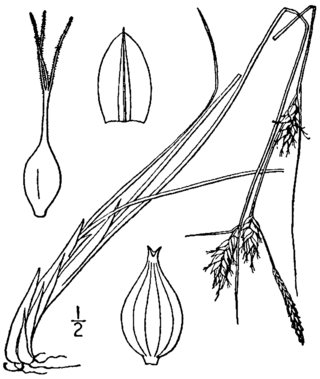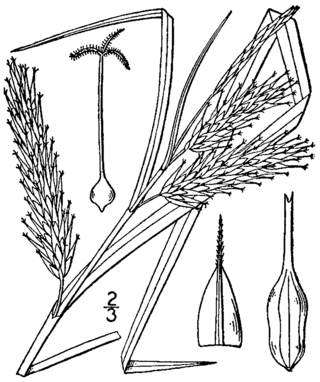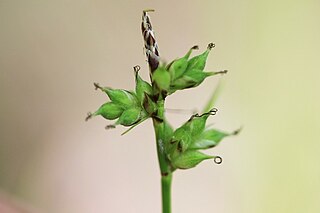
Carex chordorrhiza, commonly called creeping sedge or string sedge, is a species of perennial plant in the family Cyperaceae with Holarctic distribution growing in acidic bogs.

Carex nigra is a perennial species of plants in the family Cyperaceae native to wetlands of Europe, western Asia, north Africa, and eastern North America. Common names include common sedge, black sedge or smooth black sedge. The eastern limit of its range reaches central Siberia, Turkey and probably the Caucasus.

Schoenoplectus pungens is a species of flowering plant in the sedge family known as common threesquare, common three-square bulrush and sharp club-rush. It is a herbaceous emergent plant that is widespread across much of North and South America as well as Europe, New Zealand and Australia.

Carex lutea is a rare species of sedge known by the common names golden sedge and sulphur sedge. It is endemic to North Carolina, where it is known only from Pender and Onslow Counties in the Cape Fear River watershed. There are nine populations. The plant was discovered in 1991 and described to science as a new species in 1994, and it has not been thoroughly studied nor completely surveyed yet. Its rarity was obvious by 2002, however, when it was federally listed as an endangered species.

Carex lacustris, known as lake sedge, is a tufted grass-like perennial of the sedge family (Cyperaceae), native to southern Canada and the northern United States. C. lacustris us an herbaceous surface-piercing plant that grows in water up to 50 cm (1.6 ft) deep, and grows 50–150 cm (1.6–4.9 ft) tall. It grows well in marshes and swampy woods of the boreal forest, along river and lake shores, in ditches, marshes, swamps, and other wetland habitat. It grows on muck, sedge peat, wet sand or silt, in filtered or full sunlight.

Carex tuckermanii, commonly known as Tuckerman's sedge, is a species of true sedge in the family Cyperaceae. It is a perennial plant native to North America.

Carex castanea, known as chestnut sedge, is a species of flowering plant in the sedge family (Cyperaceae) native to North America. It is listed as endangered in Connecticut, Massachusetts, and New Hampshire. It occurs from Manitoba to the eastern seaboard in Canada and from Minnesota to New England in the United States. It is sometimes called chestnut woodland sedge or chestnut-colored sedge.

Carex davisii, known as Davis' sedge or awned graceful sedge, is a species of Carex native to North America. It is listed as an endangered, threatened, or species of concern across much of edge of its range. It was named in the 1820s by Lewis David de Schweinitz and John Torrey in honor of Emerson Davis (1798–1866), a Massachusetts educator and "enthusiastic student of the genus" Carex.

Carex novae-angliae, the New England sedge, is a Carex species that is native to North America.

Carex oligosperma, common name fewseed sedge, few-seeded sedge, and few-fruited sedge, is a perennial plant in the Carex genus. A distinct variety, Carex oligosperma var. oligosperma, exists.

Carex schweinitzii, common name Schweinitz's sedge, is a Carex species native to North America. It is a perennial.

Carex brevior, known as shortbeak sedge and plains oval sedge, is a species of sedge native to North America. The specific epithet brevior means "shorter" in Latin.

Carex viridula, known as little green sedge, green sedge, or greenish sedge, is a small flowering plant native to North America, Europe, Asia, and Morocco.

Scleria verticillata, known as low nutrush or whorled nutrush, is a plant in the sedge family Cyperaceae. It is native to Ontario, Canada, the eastern United States, The Bahamas, and Cuba.

Carex juniperorum, the juniper sedge, is a perennial flowering plant native to North America, first described by botanist William J. Crins in 1993. C. juniperorum is in the Cyperaceae (sedge) family, and is closely related to C. jamesii and C. willdenowii. It is commonly called juniper sedge as it is often seen growing in areas with red cedar, though the presence of cedar is not necessarily a requirement for it to grow.

Carex baileyi is a sedge in section Vesicariae the genus Carex native to the Appalachian mountains in Eastern North America. It is commonly called Bailey's sedge. Carex baileyi was named in honor of Liberty Hyde Bailey by its discoverer, Nathaniel_Lord_Britton.
William "Bill" J. Crins is a botanist, naturalist, and ecologist.

Carex peckii, Peck's sedge, Peck's oak sedge, or white-tinged sedge, is a species of sedge native to Canada and the United States.

Carex atlantica, the prickly bog sedge, is a species of flowering plant in the family Cyperaceae, native to eastern North America, and eastern Hispaniola. It is usually found growing in bogs or acidic seeps.

Carex feta, the green-sheathed sedge or greensheath sedge, is a species of flowering plant in the family Cyperaceae, native to southwestern British Columbia in Canada, and Washington, Oregon, and California in the United States.


















